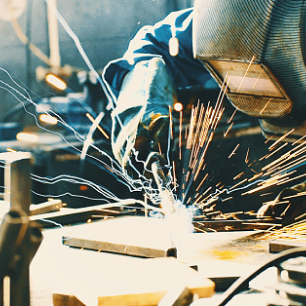Jump to:
What Is GMAW? A Comprehensive Overview of the GMAW Process
Gas metal arc welding (GMAW), commonly known as MIG welding, is one of the most versatile and efficient arc welding processes. This guide provides an in-depth look into the GMAW process, covering everything from the basics of setup to advanced techniques, with links to key AWS resources.
Understanding GMAW Welding: Definition, Process, and Applications
What Is GMAW Welding? A Detailed Definition
Gas metal arc welding (GMAW) is an electric arc welding process that uses a continuously fed wire electrode and shielding gas to join metals. The process is favored for its speed and versatility, making it ideal for various industries, including automotive, aerospace, energy, and manufacturing.
How Does the GMAW Process Work?
In GMAW, a consumable electrode is fed continuously through a welding gun while an electric arc is created between the electrode and the workpiece. The heat from the arc melts both the electrode and the workpiece, allowing them to fuse. Shielding gas protects the molten weld pool from contamination. This process is known for its clean, high-quality welds.
Key Elements for Successful GMAW Welding
Setting Up Your GMAW Equipment: Current, Voltage, and Materials
To achieve optimal GMAW results, it’s essential to adjust your equipment correctly. Current and voltage settings vary depending on the material type and thickness, and selecting the right shielding gas ensures a clean weld.
- Mild Steel: Requires a carbon dioxide and argon mix.
- Stainless Steel: A tri-mix gas blend provides optimal results.
- Aluminum: Pure argon is commonly used for clean, effective welding.
Shielding Gases in GMAW Welding: Why They Matter
The type of shielding gas directly impacts the quality of your weld. For mild steel, a mixture of carbon dioxide and argon is typically used. Stainless steel often requires a tri-mix, while aluminum welding calls for pure argon gas. The right gas combination helps control weld pool characteristics and prevent defects.
GMAW for Beginners: Your Step-by-Step Guide to Getting Started
GMAW Welding for Beginners: Why It’s Ideal for New Welders
GMAW is the preferred method for beginners because it’s relatively easy to learn and offers fast, clean welds with minimal spatter. Compared to other arc welding processes, such as SMAW (stick welding), GMAW allows for faster travel speeds and higher deposition rates, making it ideal for both beginners and professionals.
How to Master GMAW: Basic Techniques for New Welders
- Wire Feed Speed and Voltage Settings: These need to be adjusted based on material thickness and type.
- Proper Gun Angle: Hold the welding gun at a 15-degree angle from vertical to create an effective arc.
- Travel Speed: Ensure consistent speed to prevent undercuts or excess spatter.
By mastering these basics, you can quickly gain confidence and control over your welding.
Advancing Your GMAW Skills: Specialized Techniques for Professionals
Specialized GMAW Techniques: Welding Aluminum and Low Voltage Short-Circuiting
For more advanced applications, such as welding aluminum, it’s important to use a spool gun and adjust settings to control heat input. Low voltage short-circuiting is another technique used for welding thin materials, where the electrode makes contact with the base metal and briefly shorts, providing better control.
These techniques are essential for expanding your welding capabilities, whether you’re working in manufacturing or aerospace.
Frequently Asked Questions About GMAW Welding
Is GMAW the Same as MIG Welding?
Yes, GMAW and MIG welding are essentially the same. MIG welding is a specific type of GMAW that uses inert gases such as argon for shielding. GMAW can use a range of gases depending on the material being welded.
What Are the Key Differences Between GMAW and SMAW?
While GMAW uses a continuous wire feed and shielding gas, SMAW (stick welding) uses a consumable electrode coated in flux. GMAW is faster and cleaner, but SMAW is often preferred for outdoor or remote applications due to its portability.
What Are the Disadvantages of GMAW Welding?
Some disadvantages include the need for shielding gas (which limits portability) and the requirement for clean base materials. Additionally, GMAW may not provide as much penetration on thicker materials compared to other welding processes.
Whether you're just starting out or refining your technique, mastering GMAW welding opens the door to work across a wide range of industries. To take the next step in your welding journey, explore the training resources available through AWS.


